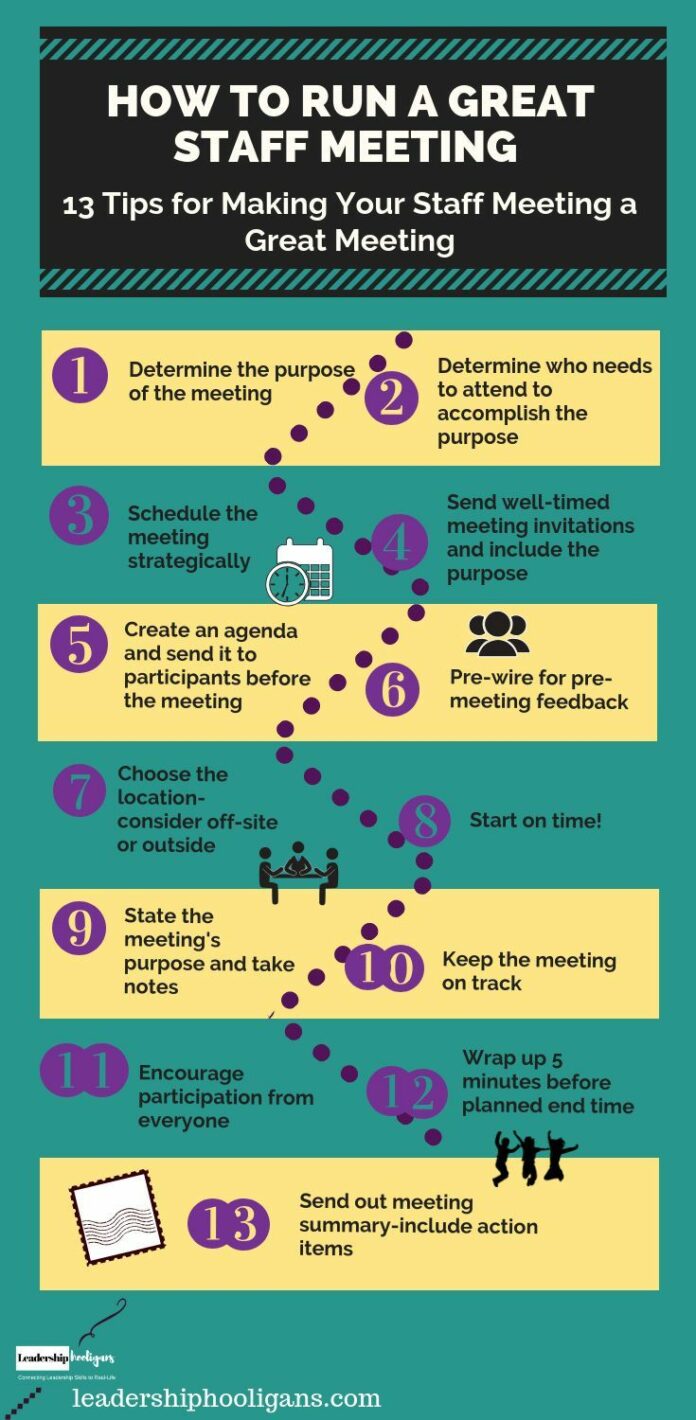Learn How to Run an Effective Meeting in 2023 PDF Guide
Top 5 Rules of a Good Meeting PDF Guide
1- Set goal(s) for the meeting and prepare an agenda
- Prepare yourself – prioritize issues to be discussed, issues from previous meetings
- Consult with other members and exec board to finalize the agenda
- Research information necessary for making important decisions
2- Arrange all logistics.
- Find a comfortable and convenient meeting place
- Arrange in advance for A-V equipment, flip charts, markers, and other supplies
- Arrive early to set up
- Check for adequate lighting, ventilation, heat
- Set up seating arrangements
- Prepare directional signs and post them in key spots of the building
- Provide nametags
- Greet people as they arrive
- Supply refreshments, if appropriate
3- Send out announcements, invitations, and reminders for meetings.
- Invite guest speakers to present on special topics/issues
- Invite all relevant constituents, target audience
- Send general and personal invitations early, send reminders
- Circulate agenda, minutes, and background information in advance
4- Be courteous, respectful, and inclusive.
- Start and finish meetings on time
- Set a welcoming tone: introductions (ice breaker)
- Engage all participants during meeting
5- Bring closure.
- Come to resolutions
- Preparing an action plan
- Summarize the main points and what and how follow-up will be accomplished
- Plan next meeting
Facilitator’s Role in a Meeting
1- One of your most important roles is to create a warm and friendly atmosphere so members feel free to express themselves.
2- Be interested and enthusiastic–enthusiasm can be contagious. Have a positive attitude!
3- Your job as a facilitator will take all your attention. You are not a participant as much as you are the “conductor” of the meeting–directing the flow and energy of that meeting. You will be looking at participants’ body language, listening carefully to what they say, drawing out those members who are not speaking, and gently moving the meeting along when a member monopolizes conversations. You will not have time to take minutes (and we know how minutes are essential in recording meeting developments, and also in reminding you and group members of follow-up actions that are needed). So, be sure to appoint another person to take minutes.
4- Set out ground rules for the meeting, including, for example, the expectation that
everyone participate, no judgement statements during brainstorming sessions,
and that there will be an ending time, and state that time.
5- Keep the discussion on track. The agenda will drive these discussions.
6- Pace the meeting and observe specified time limits for agenda items–this will allow everyone a chance to speak and helps insure that all issues on the agenda are covered. However, be sensitive to the need for discussion. Allow the group to talk things through. If they want more time to discuss an issue, adjust the agenda. Recognize when there is consensus and move on. Be gentle but firm with people who speak too long or get off the subject–a simple “let’s move on” or “thanks, now let’s hear from someone else” can be very effective.
7- Call group members by name. This personalizes the discussion and also assists the recorder in accurately noting who shared their opinions.
8- Avoid stating that a person is wrong for any idea or opinion that is expressed; rather ask for other comments and ideas on the subject. Remain open-minded and democratic. Allowing the free flow of expression allows for creative thinking.
9- Ask open-ended questions–why and how–to stimulate discussion. Ex. How to do you think that will impact the project? vs. Do you think that will impact the project?- which dead ends with a “no” or “yes” response.
10- Listen carefully to each person. Make sure you understand what the speaker is saying. If you’re unsure, try restating it or ask the person to clarify.
11- Be certain that the entire group is involved in the discussion. Encourage everyone to speak by simply asking those who haven’t spoken for their opinion on the issue at hand.
12- Be aware of people who look confused or lost, and restate questions or ideas. Summarize key points when necessary.
13- If problems arise, remain neutral and calm. Call on members for assistance and resolution–it shouldn’t all be on your shoulders.
14- Use appropriate humor–it can release tension and get people talking.
15- Summarize conclusions or decisions at the end of the meeting.
16- Leave time for questions. Otherwise, your meetings will seem like one-sided dialogues.
17- Recognize achievements, big and small. We all want to feel valued.
How to Conduct Effective Meetings
Do you know how to conduct a meeting? Meetings are an essential part of the life of every organization and your ability to run effective meetings with your management skills is a critical part of your success in meeting management.
Watch this video and learn how you can use a meeting agenda and different problem-solving techniques to make your meetings extremely productive.


